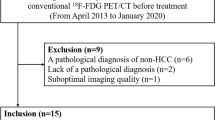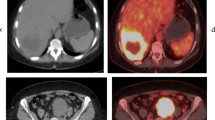Abstract
Objective
To integrate CT-perfusion into a routine, clinical contrast-enhanced (ce) PET/CT protocol for the evaluation of liver metastases and to compare functional CT and PET parameters.
Materials and methods
Forty-six consecutive patients (mean age: 60 (34–82) years; 20 f, 26 m) with known liver lesions (colorectal metastases (n = 34), primary liver cancer (n = 4), breast cancer (n = 3), anal cancer, gastric cancer, esophageal cancer, GIST, duodenal cancer (all: n = 1) who were referred for staging or therapy follow-up by [18F]-Fluoro-2-deoxy-D-glucose-positron-emission-tomography/computed-tomography imaging (FDG-PET/CT) were included. After acquisition of a low-dose PET/CT, a split-injection (70–90 mL) ce-CT-protocol, including a 35-s CT-perfusion scan of the liver and a diagnostic ce-CT of the thorax and/or abdomen (70 s delay, iv-contrast volume: 90 mL, 4 mL/s) was performed. CT-perfusion parameters (BF, BV, MTT,) and semi-quantitative PET-parameters (SUVmax, SUVmean, TLG, PETvol) were analyzed and compared.
Results
CT-perfusion data could be obtained in all but one patient with shallow breathing. In all patients, diagnostic ce-PET/CT quality was adequate without the use of additional contrast media. Significant correlations (P < 0.05) were found for each of BF, BV, MTT, and SUVmax, further, BF and MTT correlated with TLG. Several other correlations were seen for other perfusion and PET-parameters.
Conclusion
Combined CT-perfusion/PET/CT-protocol without the use of additional contrast media is feasible and can be easily integrated in clinical routine. Perfusion parameters and PET-parameters are only partly correlating and therefore have to be investigated further at fixed time points during the course of disease and therapy.



Similar content being viewed by others

References
Bellomi M, Petralia G, Sonzogni A, Zampino MG, Rocca A. CT perfusion for the monitoring of neoadjuvant chemotherapy and radiation therapy in rectal carcinoma: initial experience. Radiology. 2007;244:486–93
Miles KA, Griffiths MR, Keith CJ. Blood flow-metabolic relationships are dependent on tumour size in non-small cell lung cancer: a study using quantitative contrast-enhanced computer tomography and positron emission tomography. Eur J Nucl Med Mol Imaging. 2006;33:22–8
Sahani DV, Holalkere NS, Mueller PR, Zhu AX. Advanced hepatocellular carcinoma: CT perfusion of liver and tumor tissue–initial experience. Radiology. 2007;243:736–43
Sahani DV, Kalva SP, Hamberg LM, et al. Assessing tumor perfusion and treatment response in rectal cancer with multisection CT: initial observations. Radiology. 2005;234:785–92
Bisdas S, Spicer K, Rumboldt Z. Whole-tumor perfusion CT parameters and glucose metabolism measurements in head and neck squamous cell carcinomas: a pilot study using combined positron-emission tomography/CT imaging. Ajnr. 2008;29:1376–81
Groves AM, Wishart GC, Shastry M, et al. (2009) Metabolic-flow relationships in primary breast cancer: feasibility of combined PET/dynamic contrast-enhanced CT. Eur J Nucl Med Mol Imaging 36(3):416–421
Thomas JP, Arzoomanian RZ, Alberti D, et al. Phase I pharmacokinetic and pharmacodynamic study of recombinant human endostatin in patients with advanced solid tumors. J Clin Oncol. 2003;21:223–31
Wang JH, Min PQ, Wang PJ, et al. Dynamic CT Evaluation of Tumor Vascularity in Renal Cell Carcinoma. AJR Am J Roentgenol. 2006;186:1423–30
Willett CG, Boucher Y, di Tomaso E, et al. Direct evidence that the VEGF-specific antibody bevacizumab has antivascular effects in human rectal cancer. Nature medicine. 2004;10:145–7
Yi CA, Lee KS, Kim EA, et al. Solitary pulmonary nodules: dynamic enhanced multi-detector row CT study and comparison with vascular endothelial growth factor and microvessel density. Radiology. 2004;233:191–9
Schoder H, Carlson DL, Kraus DH, et al. 18F-FDG PET/CT for detecting nodal metastases in patients with oral cancer staged N0 by clinical examination and CT/MRI. J Nucl Med. 2006;47:755–62
Schoder H, Larson SM, Yeung HW. PET/CT in oncology: integration into clinical management of lymphoma, melanoma, and gastrointestinal malignancies. J Nucl Med. 2004;45 Suppl 1:72S-81S
Strobel K, Dummer R, Husarik DB, et al. High-risk melanoma: accuracy of FDG PET/CT with added CT morphologic information for detection of metastases. Radiology. 2007;244:566–74
Valk PE, Abella-Columna E, Haseman MK, et al. Whole-Body PET Imaging With [18F]Fluorodeoxyglucose in Management of Recurrent Colorectal Cancer. Arch Surg. 1999;134:503–11. 10.1001/archsurg.134.5.503
Veit-Haibach P, Kuehle, CA, Beyer, T, et al. (2006) Whole-body PET/CT-colonography: diagnostic accuracy of a new staging concept in patients with colorectal cancer. JAMA 296(21):2590–2600
Hillner BE, Siegel BA, Liu D, et al. Impact of positron emission tomography/computed tomography and positron emission tomography (PET) alone on expected management of patients with cancer: initial results from the National Oncologic PET Registry. J Clin Oncol. 2008;26:2155–61
Goh V, Halligan S, Gharpuray A, et al. Quantitative assessment of colorectal cancer tumor vascular parameters by using perfusion CT: influence of tumor region of interest. Radiology. 2008;247:726–32
Einstein AJ, Moser KW, Thompson RC, Cerqueira MD, Henzlova MJ. Radiation dose to patients from cardiac diagnostic imaging. Circulation. 2007;116:1290–305
Kiessling F, Boese J, Corvinus C, Ederle JR, et al. Perfusion CT in patients with advanced bronchial carcinomas: a novel chance for characterization and treatment monitoring? Eur Radiol. 2004;14:1226–33
Meijerink MR, van Cruijsen H, Hoekman K, et al. The use of perfusion CT for the evaluation of therapy combining AZD2171 with gefitinib in cancer patients. Eur Radiol. 2007;17:1700–13
Meijerink MR, van Waesberghe JH, van der Weide L, et al. Total-liver-volume perfusion CT using 3-D image fusion to improve detection and characterization of liver metastases. Eur Radiol. 2008;18:2345–54
Miles KA (2003) Perfusion CT for the assessment of tumour vascularity: which protocol? Br J Radiol 76(spec no 1):S36–S42
Chung YE, Kim KW, Kim JH, et al. Optimal delay time for the hepatic parenchymal enhancement at the multidetector CT examination. Journal of computer assisted tomography. 2006;30:182–8
Groves AM, Wishart GC, Shastry M, et al. Metabolic-flow relationships in primary breast cancer: feasibility of combined PET/dynamic contrast-enhanced CT. European journal of nuclear medicine and molecular imaging. 2009;36:416–21. doi:10.1007/s00259-008-0948-1
Hermans R, Lambin P, Van der Goten A, et al. Tumoural perfusion as measured by dynamic computed tomography in head and neck carcinoma. Radiother Oncol. 1999;53:105–11
Kan Z, Phongkitkarun S, Kobayashi S, et al. Functional CT for quantifying tumor perfusion in antiangiogenic therapy in a rat model. Radiology. 2005;237:151–8
Sabir A, Schor-Bardach R, Wilcox CJ, et al. Perfusion MDCT enables early detection of therapeutic response to antiangiogenic therapy. AJR Am J Roentgenol. 2008;191:133–9
Akhurst T, Ng VV, Larson SM, et al. Tumor Burden Assessment with Positron Emission Tomography with. Clin Positron Imaging. 2000;3:57–65
Francis RJ, Byrne MJ, van der Schaaf AA, et al. Early prediction of response to chemotherapy and survival in malignant pleural mesothelioma using a novel semiautomated 3-dimensional volume-based analysis of serial 18F-FDG PET scans. J Nucl Med. 2007;48:1449–58
Steinert HC, Santos Dellea MM, Burger C, Stahel R. Therapy response evaluation in malignant pleural mesothelioma with integrated PET-CT imaging. Lung Cancer. 2005;49 Suppl 1:S33–5
Acknowledgments
we would like to thank Sabine Knoefel, RT, for her great contribution to this study.
Author information
Authors and Affiliations
Corresponding author
Rights and permissions
About this article
Cite this article
Veit-Haibach, P., Treyer, V., Strobel, K. et al. Feasibility of integrated CT-liver perfusion in routine FDG-PET/CT. Abdom Imaging 35, 528–536 (2010). https://doi.org/10.1007/s00261-009-9559-y
Received:
Accepted:
Published:
Issue Date:
DOI: https://doi.org/10.1007/s00261-009-9559-y



